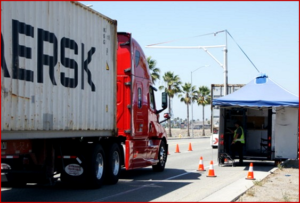The California Air Resources Board (CARB) has previewed its Heavy-Duty Inspection and Maintenance Program (HD I/M), which is due to begin phasing in on 1 Jan. 2023, at an enforcement truck event held at the Port of Los Angeles. More than 1200 trucks were screened, to help make owners and operators aware of the new ‘smog check’ requirements for heavy-duty vehicles and the phase-in timeline.
The progressive public health program is the first in the nation of its kind and will ensure that emissions control systems on heavy-duty vehicles operate effectively for the life of the vehicle, improving air quality and protecting public health. The HD I/M program will apply to all heavy-duty trucks, buses, agricultural equipment and personal motor-homes with a Gross Vehicle Weight Rating (GVWR) of more than 14,000 pounds traveling in the state regardless of whether they are registered in California. (AutoInformed.com on: Death of the Diesel – CARB Approves Truck, Bus Smog Checks; CARB – New Diesel Regs Cost Effective, Lobbyists Wrong; CARB OK’s Record $1.5B for Clean Vehicles, Mobility Options)
“The Heavy-Duty Inspection and Maintenance Program will ensure that the emissions control equipment in heavy-duty trucks does its job capturing and removing harmful emissions for the life of the vehicle. And, if we discover it’s not working properly, it will be repaired quickly,” said CARB Chair Liane Randolph. “This will save owners and operators in fuel costs and deliver significant improvements in air quality and public health especially in communities adjacent to highways, ports and warehouses that suffer from persistent air pollution as a result of heavy traffic.”
Heavy-duty vehicles under this program comprise only 3% of all vehicles on California roads. However, they are responsible for more than half of all harmful smog-causing pollution and fine particulate matter from mobile sources in the state. By ensuring that trucks continue to run clean for the life of the vehicle, CARB said the new program is expected to deliver $75 billion in health benefits, prevent 7,500 air-quality related deaths and 6,000 hospitalizations and emergency room visits from 2023 to 2050. These benefits are 18 times the estimated cost of the program at $4 billion.
In the first phase of the program, beginning in January 2023, the Portable Emissions Acquisition System (PEAQS) – a roadside monitoring system that measures truck emissions – will be used in various areas to screen for potential high-emitting vehicles operating on California roads. Vehicles flagged by the monitoring devices will be required to undergo an additional emissions test to verify their emissions-control equipment is functioning properly and repair any malfunctioning emission control equipment, if necessary.
In mid-2023, phase two of the HD I/M program requires all heavy-duty trucks to register with CARB and obtain a certificate of compliance to operate in the state.
In 2024, in the last phase of the program, heavy-duty truck registration in California will require proof of emissions compliance with the HD I/M Program. Emissions inspections will need to be performed twice a year for vehicles with onboard diagnostic (OBD) systems, increasing to four times per year testing in 2027.
CARB says that inspections are designed to minimize downtime and the inconvenience to owners/ operators. Unlike passenger car smog checks, heavy-duty vehicle owners will be able to complete the required test and deliver emissions systems inspection information remotely without having to travel to designated testing locations. The test can be conducted anywhere using the truck’s OBD system or stand-alone scan tool provided it’s performed by a CARB-credentialed tester using a CARB-certified readout device. It is projected that 75-80% of all heavy-duty trucks will have OBD equipment that can use telematics technology sending the data automatically when the program begins. Older heavy-duty vehicles without an OBD system will continue the current opacity testing requirements with an added visual testing component, twice each year.



The California Air Resources Board (CARB) has extended the reporting deadline for Clean Truck Check, giving heavy-duty truck owners and operators an additional month to enter their information into a new database that will track compliance. Vehicle/fleet owners now have until Jan. 31, 2024, to finalize the initial reporting requirement and compliance fee payment for 2023. Vehicle/fleet owners are required to report in the new Clean Truck Check-Vehicle Inspection System (CTC-VIS) reporting database.
The goal of the new Clean Truck Check program, previously known as the Heavy-Duty Inspection and Maintenance (HD I/M) Regulation, is to reduce air pollution in California communities by preventing high-polluting buses or trucks from registering for operation in California and encouraging the rapid repair of malfunctioning emissions systems. The new reporting requirements aim to increase convenience for fleet operators, making it possible for properly equipped vehicles to submit smog-check results remotely without traveling to a designated testing location.
After registration is finalized and annual compliance fees are paid, the next compliance milestone is projected to take place in July, when heavy-duty vehicle owners will need to report in CTC-VIS the results of a smog check that ensures that the vehicle’s emissions control systems are properly functioning or that they have completed needed repairs. In order to determine applicable compliance deadlines, visit the Clean Truck Check program page. The reporting database (CTC-VIS) opened on Oct. 1, 2023, and for a vehicle to be considered compliant, owner and vehicle information must be reported, annual compliance fees paid, and periodic testing requirements met by the applicable deadline; the Jan. 31 deadline is to ensure compliance for 2023.